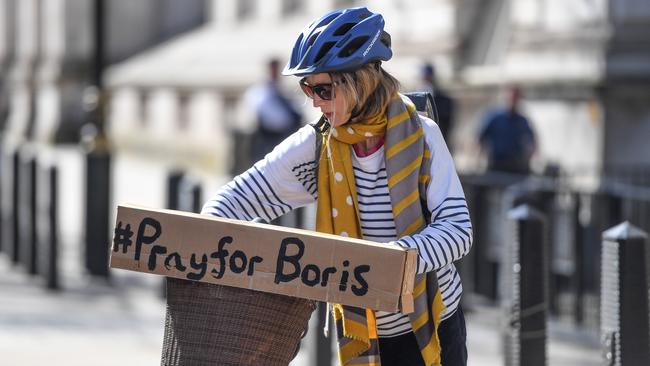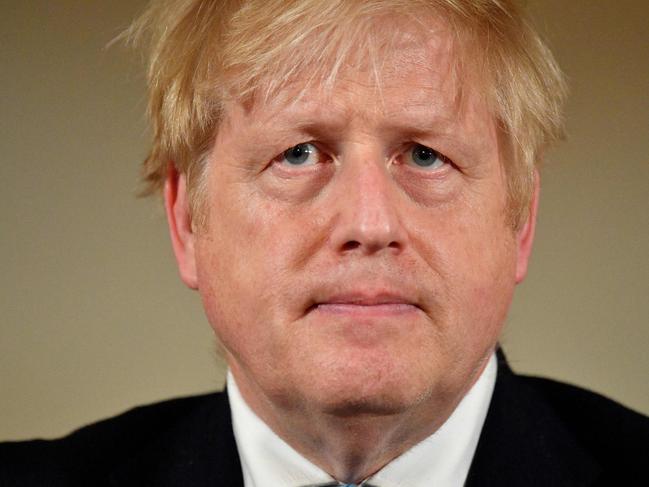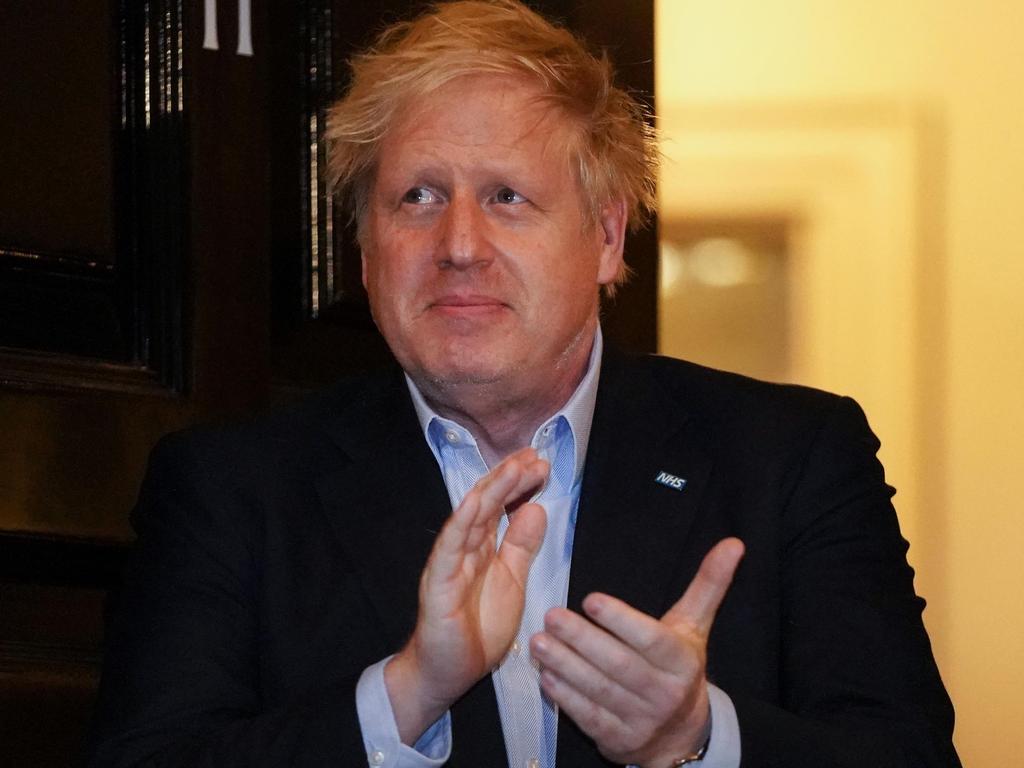‘I’m going to pray’: Boris Johnson’s chances of COVID-19 recovery were ‘50-50’
Boris Johnson has left hospital, marking his most astonishing comeback yet. But for Britain the crisis goes on.

When a senior figure in the government contacted a member of Boris Johnson’s family on Thursday to celebrate the prime minister’s release from intensive care, they responded with an affectionate joke about his timely resurrection: “He is risen.”
A week earlier, when cabinet ministers first predicted that Easter would be the crunch time for the coronavirus crisis, they had no idea that Johnson’s own life would be on the line as well as the future of the country.
The UK prime minister is keeping his mind occupied with sudoku number puzzles, preparation perhaps for what lies ahead. This weekend his government is engaged in a gigantic data-gathering exercise in an effort to work out when and how Britain can move from the lockdown to something resembling normal life.
Just days earlier it was not even clear Johnson would have a role to play in that decision. At 8pm on Monday, as his health went downhill fast, he was moved to an intensive care unit at St Thomas’ Hospital, over the river from parliament, and fitted with an oxygen mask.
The “golden triangle” of Sir Mark Sedwill, the cabinet secretary, Martin Reynolds, Johnson’s principal private secretary, and Sir Edward Young, the Queen’s private secretary, went into action to ensure continuity of government and that the monarch was informed.
Sedwill hastily convened a conference call with the cabinet. “Everyone was shell-shocked,” said one cabinet source. “You’ll do all these meetings and you see staggering statistics, but when the PM is shot down, it just brings it home.”
When he had been admitted to hospital a day earlier, Johnson had confirmed that Dominic Raab, the foreign secretary, would deputise for him where necessary. But it was Michael Gove who said on the video-call: “I think I speak for everyone when I say our thoughts and prayers are with the prime minister.”

On Monday night, aides and ministers exchanged bleak phone calls and messages about COVID-19 survival rates. “It’s 50-50,” was the common refrain. For a tight-knit group who see Johnson as their talisman as well as their boss, it was a shattering experience. One aide said: “I’m going to pray.”
Yet, in a comeback that his political opponents will recognise, by Thursday Johnson was chatting happily with his nurses and by Friday he was taking tentative steps. Aides had loaded his secure iPad with favourite films such as Withnail & I and the Lord of the Rings trilogy. His fiancee, Carrie Symonds, had been sending him scan pictures of their unborn child, due in early summer.
The prime minister himself was clear that his revival was not the result of divine intervention. “The NHS [National Health Service] has saved my life,” he told those who cared for him. “The treatment has been exemplary.”
The prime minister who risked becoming a statistic is under pressure from aides to take weeks, not days, to fully recover. “I don’t think he should be coming back to work any time soon,” one said. “It will have been a shock and hopefully enough to convince him that he needs to take it easy.”
Raab, who chaired the key 9.15am video conference calls of the COVID-19 war cabinet last week, was equally clear that he was just minding the shop for Johnson’s return. One minister recalled him saying, “We’ve all got our jobs to do,” then adding: “Let’s get on and do them and make sure when the boss gets back that we’ve got on with the plan.”
Colleagues say that Raab has “not tried to stand on other people’s toes”. But a source said his fellow ministers were “pointedly referring to him in meetings as ‘foreign secretary’ rather than ‘first secretary of state’”, the title that gives him seniority.
The big question is how quickly ministers will move to enact Johnson’s stated wish before he fell ill, to ease lockdown, an issue on which he is the biggest hawk in government. “More a golden eagle,” as a source who was in close contact with ministers last week put it.
Johnson, like Treasury ministers, had been alarmed that so many people had listened to instructions to “stay at home” and stopped working, threatening a 15 per cent fall in economic output. “We have all been surprised how obedient the public has been,” said one cabinet minister, “because, to be frank, initial compliance was terrible.”
The doves include Matt Hancock, the health secretary, whose priority is the NHS and saving lives. Hawks talk about beginning to lift the restrictions after the first May bank holiday on Friday, May 8, which was brought forward to coincide with the 75th anniversary of VE Day. The doves believe any changes should wait until after the second May bank holiday on Monday 25, with some restrictions continuing for months.
Ministers and advisers insist that Hancock and Rishi Sunak, the chancellor of the exchequer, have not fallen out. “Departments institutionally have different priorities,” a source said. “But Rishi cares about protecting lives and Matt doesn’t want the economy to tank.”

An attempt is being made to square the circle by comparing the number of people who are likely to die from the virus with those who might succumb to heart problems, cancer or mental health problems caused by the lockdown. “There is an impact on mental health and suicide attempts, and a fall in GDP leads to an increase in ill health through poverty,” said a cabinet source. “You have the issue of operations being cancelled and that has an impact too. When you talk about health, it’s not just people dying in hospital from the coronavirus. You need to look at it in the round.”
At a meeting of the Cobra emergency meeting on Thursday, ministers were presented with a 60-page document put together by “scientists and data geeks” featuring modelling on this issue. But at this point there is not enough data to make the decision. “People know there’s a trade-off between ‘x’ and ‘y’ but we don’t yet know what ‘x’ is or what ‘y’ is,” said one government aide.
The scientific advisory group for emergencies (Sage) will meet on Thursday to try to determine the effect the lockdown has had on infections and deaths. Ministers expect it will then take a further week or 10 days for the cabinet to come up with a plan.
The number of indirect deaths from the continuing lockdown will be more difficult to prove. One document passed around Whitehall last week concluded that the avoidable deaths could hit 150,000, dwarfing the 20,000-plus likely victims of the coronavirus. However, one of those who read it said: “That briefing was predicated on all NHS activity stopping, which it hasn’t. Lifesaving operations continue.”
Others believe attempts to use projections for other deaths to justify an end to the lockdown is politically flawed. A cabinet minister said: “Real deaths happening now are more politically powerful than projections from a model.”
Nonetheless, outside the Department of Health, cabinet ministers are receiving real-time information from their own departments that is increasing pressure for a change. “I can’t think of many people outside health who want things to stay the same,” a Tory adviser said. “The Treasury is getting jittery because they can see what is happening to GDP, what’s happening to businesses and growth.”
Robert Jenrick, the communities secretary, has been shown data on the impact of empty social housing and rising domestic violence. Gavin Williamson, the education secretary, wants the schools to reopen sooner rather than later. Ministers expected them to operate at 20 per cent capacity during lockdown. Instead, just 2 per cent of pupils have turned up.
“There are social housing properties lying empty. If you’re Jenrick, you know there are a whole load of people sitting in hostels who can’t move into a house, people cooped up in homes where kids have bad lives, families with an abusive parent,” a source said. “If you’re Gavin, you know there are a load of kids not getting free school meals, (suffering) malnutrition or suffering child abuse.”
The problem is that even if the lockdown is eased, ministers are not confident people would go back to work. A cabinet minister said: “The fear factor is the issue we need to overcome soon.” Another source said: “Even if you reopen schools, you can’t force parents to put their kids in.”

Yet that is seen as an essential step to encourage parents back to work amid clear warnings that unemployment is set to rise beyond the levels last seen under Margaret Thatcher almost 40 years ago. More than 1.2 million people have already made a new claim for universal credit since the crisis began. Not all of those will be out of work, but two senior sources have said that the government’s central estimate is between three million and four million people unemployed as a direct result of the crisis.
Some in the Department for Business fear that the figure over the next 12 months could be even worse when the government’s scheme to pay the salaries of furloughed workers ends. “People will come off furloughing and find out they are being made redundant,” said a source who has been working with ministers on how to help business. “You could see four million to six million people lose their jobs over the next 12 months.”
What will the plan to lift the lockdown look like? In the past week, suggestions have been floated that young people, or those in least affected regions, could see the lockdown restrictions lifted first. But cabinet ministers say Johnson has repeatedly insisted the whole country should be treated the same.
“Boris has previously said that it would be ‘ridiculous’ to have the pubs closed in Uxbridge but people could get in a car and have a drink in Epsom,” a cabinet minister said. “I would expect all actions to be at a national level.”
Instead, ministers and aides say there will be a “sectoral approach”, where more jobs are given key worker status. “Government agencies that deal with those issues like housing and child neglect, which are getting worse, will be moved into the key worker category,” a source said.
Opticians, hairdressers and support workers such as cleaners, who are needed to help big companies function, might be in the first wave. “There are some very delicate chats going on with the trade unions,” a Whitehall source said. “If you can get some of these support services back, you can start to get businesses working again.”
George Eustice, the environment secretary, wants help to mobilise an “army” of agricultural workers to pick crops. “It’s a critical time for the food economy,” an adviser said. “Once the crops are gone, they are gone. They will just rot. It’s easier to space people out in the fields.”
A source who was in contact with a Premier League chairman last week said the football season will be finished but behind closed doors: “By June or July they will be playing games solely as TV events. If they have to play four games a day at Wembley to get it done, they will do that.”

Ministers expect the “peak” of the disease over the coming week in London, later elsewhere. The worst-hit area could be the Midlands, which has a higher proportion of multigenerational households.
One source compared it to Italy: “The virus spreads among young people but it kills old people. It was so bad in Italy because you had a lot of carriers living in the same home as those who were most likely to die.”
Insiders caution that, even once the peak has passed, normal life will have to wait for a vaccine and that the notion of “ending” the lockdown now is misplaced. “Some people are acting as if this is a storm that needs to be weathered and if we hold tight for long enough it will go away,” a source said. “We are going to have to learn to manage this and live with it.”
Even when they return, big firms are expected to encourage staff to work more at home, stagger their start times and work different days so they do not all need to travel at rush hour.
As for Johnson, efforts to keep him resting may prove fruitless. “I suspect by the end of this coming week he will be seeing some papers,” one cabinet minister said.
With the lockdown decision approaching like an Exocet, there is one role that colleagues feel only he can perform. Whatever the government decides to do, the new policy will need a salesman. “Who is going to make the speeches conditioning the nation for the big decisions and lifting national morale, if not Boris?” one Tory asked last week.
There will be many unpleasant jobs in the weeks ahead. One of the most difficult might be that of the person who tries to stop Johnson rising again.
The Times







To join the conversation, please log in. Don't have an account? Register
Join the conversation, you are commenting as Logout